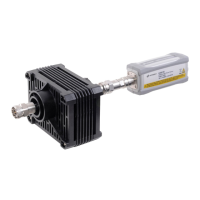Introduction 1
U2000 Series Operating and Service Guide 7
Correction Algorithm such as Linearity Correction, Calibration Factor,
Temperature Compensation Algorithm and Internal Zeroing algorithm. The
correction factors for the products are stored in a 3 MB Flash memory. In the
Temperature Compensation Algorithm and Internal Zeroing algorithm
implementation, the processor continuously monitors product temperatures
using a thermistor which is located in the vicinity of the diode sensing element
as shown in
Figure 1- 3. The trigger input port which is based on TTL enables
the product to synchronize with events. The U2000 Series supports high data
rate transfer of 480 Mb/s through the Universal Serial Bus (USB) connectivity
which is USB- TMC compliance.
External zeroing is performed similar to other power sensors - the RF power
is removed from the sensor by the user and then the sensor is zeroed. Internal
zeroing is a new type of zeroing whereby the RF power can be left connected to
the sensor while it is being zeroed. The power sensor will remove the RF power
from the diode sensor internally in the sensor.
During the external zeroing process, the data from the front end circuitry
which includes the RF diode sensing element, signal conditioning, and data
acquisition circuit will be acquired. The zero information is then used. Do not
apply any RF/microwave signals to the bulkhead during external zeroing
processes. Any RF/microwave signals pick- up by the diode sensor during the
external zeroing will be considered as part of the noise.
During internal zeroing processes, high isolation switches are opened in the
sensor to isolate the diode sensor from the electronic circuitry. With the
available processing power from the Embedded DSP in the product, the
internal zeroing algorithm is applied to the internal zero data. The internal
zeroing process simplifies the product operation by removing the circuitry
noise without requiring the RF signal to be removed from the product. Hence,
internal zeroing is able to provide the convenience of performing a zero with
the RF/microwave signal present.

